Microsoft's KIN: A Eulogy
by Brian Klug on July 13, 2010 3:42 PM EST- Posted in
- Smartphones
- Microsoft
- KIN
- Mobile
The Failure of KIN
But we all know the way this story ends - Microsoft killed the KIN.
They're not entirely dead yet, however - Verizon is still selling both the KIN ONE and TWO for $29.99 and $49.99 on contract, respectively, and Amazon is selling both KIN for $0.01. They'll keep selling until Verizon has burned through its inventory. Though launch in Europe has been completely canned, there are just under 10,000 of the KINs in the US that will continue to demand support. The real uncertainty now for KIN is whether Microsoft plans to make good on its previously promised mid summer software update.
But let's look at what really did the KIN in.
Priced like a Smartphone
For starters, the devices lacked a realistic pricing structure - despite not quite being a smartphone, Verizon priced the data plans for the KIN as if they were, at $29.99 per month. There's since been discussion that Verizon originally intended heavily reduced pricing for the KINs, but soured on the deal when Microsoft delayed release. At the right price, the KINs could have been a compelling alternative to the dying breed of featurephones. It's hard to argue that there isn't a niche that the KIN could have filled at the bottom, yet above boring featurephones. At $10 per month or less for data, the KIN would've been a much more successful sell.
Though they were billed as being attractive for children and teens, the KIN's monthly plans ended up being just as hard to swallow as any other smartphone. It just didn't make sense to buy something that wasn't quite a smartphone, yet cost just as much monthly. Next to aggressively subsidized Android devices that deliver full featured smartphone experiences, the KIN just didn't make sense when buying the handset either. Pricing aside, the KIN did have a number of other notable and ultimately fatal flaws.
Social Integration
For such a strong social networking oriented device, there's a lot that the KINs left desired with regards to all the different social media platforms it tied into. First and foremost was Twitter integration.
As shipped, the devices treat Twitter more like a one-way feed of information. You can post simple updates with text, but cannot tweet and attach photos, geotags, videos, audio recordings, or other media. To be honest, the way Twitter was integrated felt hacked on at the last minute, like Microsoft discovered the API to pull down your timeline, post updates, but ran out of time to do anything more. You can't retweet, reply (without doing it manually), view conversations, search, direct message, view your replies, or anything more. It's basic to the point of being beyond barebones. Further, while social data from Facebook and Myspace makes it into contact cards, Twitter profiles inexplicably don't sync to contacts.
There's also the weird and uncertain way that certain social data takes precedence over other social data. For example, avatars come down from Facebook, but not from Twitter.
The next confusing bit was Facebook. I think there are two extremes to Facebook integration into a platform - integrate too much, and Facebook becomes so much a part of the OS that you can't find it anymore because it's everywhere. This is how the KINs integrated faceboook; it's a part of the OS in every nook and cranny. It's in the contacts pages, in the home screen, and in all the avatars. There's no dedicated Facebook application because it's everywhere, alongside data from all the other social media sources that you're prompted to log into during setup. The downside is that there's no specific place to get just Facebook information, instead, it's scattered throughout the OS.
At the other extreme is the iOS approach, which keeps Facebook sequestered away in an application of its own, requiring you to dive into contact information and users pages through that portal rather than through the OS' contacts pages. It's easier to understand at first, but ultimately you're left managing two disparate sets of information.
In between is the Palm Pre and Android approach, which aggregates all the data in a KIN like fashion, but still provides a standalone application for everything else. Ultimately, I believe this is the sweet spot. Data that can be mashed up and aggregated into contact fields should be, but there are some things that just don't map to other parts of the phone's UI. For example, status updates and wall posts are presented in a rather nebulous fashion in the KIN "loop" homescreen, alongside other info. Things like photo albums on Facebook, notes, events, and messages - they don't have any mapping into the KIN OS. Instead, you just do without them. And no, browsing online doesn't count.
The result was that I was left consuming whatever Facebook information was tossed my way, but completely missed all my notifications, wall posts, events, and friend requests. The KIN keeps you tied into the news feed, sure, but people need more. For a completely social phone, I found consuming social media a relatively confusing experience.
Social Beings need Calendars and Maps
That brings me to what else was lacking that was rather glaring - a calendar. With the right execution, the KIN could have perfectly integrated the Facebook event calendar, invitations, and exchange or Google calendars. Instead, the KIN has absolutely no planning tools or event notifications.
It's a glaring reminder of the rift that exists between smartphones and featurephones, and a testament to how many features we take for granted on modern smartphone platforms. But it wasn't a part of KIN.
Same for maps. The KIN both included aGPS support and geotagging for photos, yet there was no bundled Bing maps application.
Communications
The Danger Hiptops famously included instant messaging support for all the major protocols when they arrived on the smartphone scene in 2002. It's hard to fathom, then, how the KIN lacks instant messaging suppor a whole 8 years later. In fact, the KIN seems like a step backwards from the Sidekicks in a few regards. Social networks are beginning to implement their own instant message protocols, namely Facebook. Microsoft and Verizon were rumored to be releasing a mid summer update that would include instant messaging support and a number of other important lacking features, but that's all up in the air right now.
Moving on, the KIN email client was basic, but lacked attachment support for almost all document formats. PDF, Word, Excel, Power Point, and OneNote documents were all unsupported. In fact, the KIN couldn't open BMP, GIF, TIF, or MP3s as attachments either. Essentially all the KIN could open were videos (WMV, MP4, 3GP, 3G2) and photos that are JPG or PNG. The email client also lacked native HTML viewing, and spell check support.
That brings me to the keyboard assists - there were none. Though both KIN had spectacularly good keyboards, they were hampered by the lack of any autocorrection, capitalization after punctuation, or spell check. It literally amounted to just the keyboard. That's fine for most things, but for pecking out emails on the device, assists are extremely useful. Generation upload might not be the best at grammar, but Microsoft could've at least helped everyone along with some auto capitalization.
Phone for Kids?
Though the KIN was aggressively marketed towards the younger demographic, it surprisingly lacked a feature parents demand in large numbers. Namely, Parental controls. In fact, I came close to suggesting the KIN to a close friend of mine for their son, before it occurred to me that a lack of parental controls made the device something the parents would never swallow. It's that kind of glaring omission that makes the KIN a tough sell.
Lack of Applications
But the real problem with the KIN was that Microsoft was launching a new phone platform in 2010 without any application marketplace - it didn't make sense.
Microsoft promised application support eventually, and even suggested that Windows Phone 7's marketplace would eventually merge with the KIN's. Of course, the reality is that the KIN had no future in a WP7 dominated roadmap.
Browser
The KIN's browser felt speedier than Internet Explorer on Windows Mobile ever felt, but still feels an order of magnitude slower than any other mobile browser. Though all of the sites I visit on a regular basis render perfectly, the KIN web browser did abysmally poorly at all the browser standards tests:


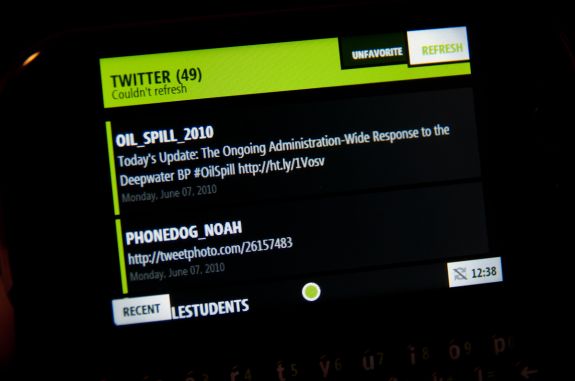
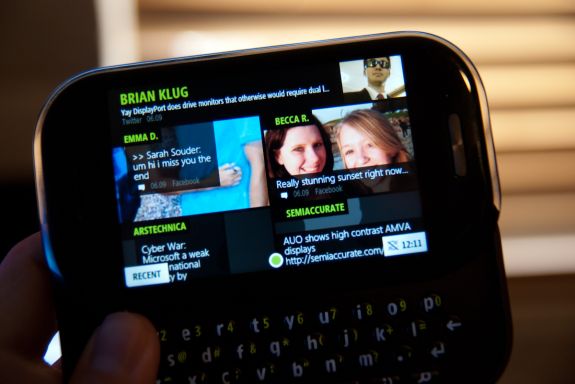
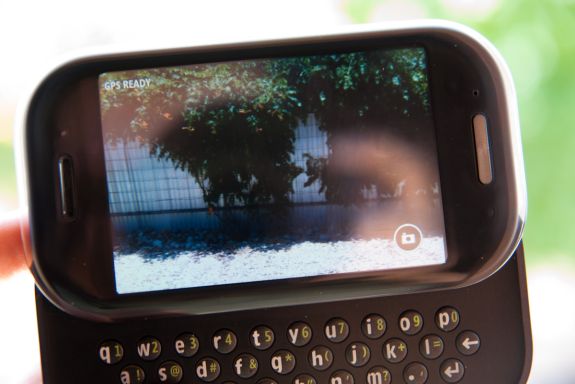


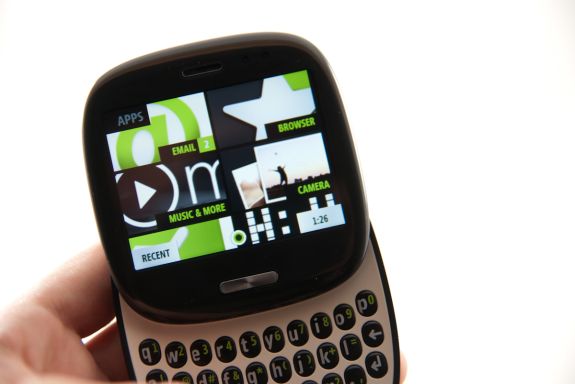
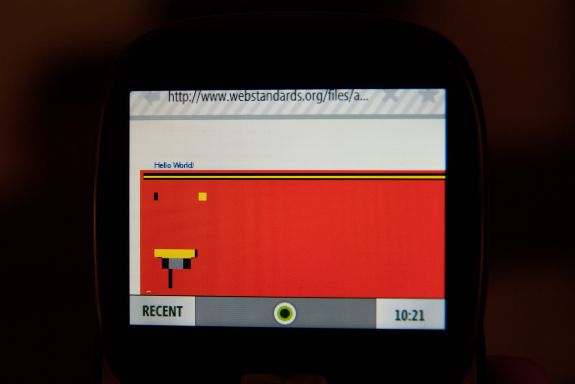















60 Comments
View All Comments
aebiv - Wednesday, July 14, 2010 - link
HD2 is a great device except for the capacitive screen. The resistive is far more accurate.s1ugh34d - Tuesday, July 13, 2010 - link
WinMo really does take all those points, and put them in a more business approached user interface, while taking notes from classic IT user requirements.My TyTn II definitely does everything the KIN, iOS, WebOS, and android phones can, just it's been able to since before them...
Now I can't say it has the flare, GUI or app style. The Microsoft app store is the worst software I ever thought to install. The graphics are something HTC has been holding back forever. Otherwise functionality speaking, I can do anything you can do, just it may take me a day to figure it out.
What it comes down to is what YOU do. I read about 75 RSS feeds daily(long commute.) I also listen to Pandora the whole time. Meanwhile between my feed reader, the browser or browsers I may be running, Pandora, and typically word/excel/foxit, I still make it 5-8 hours constant usage(which translates into a day adding in time I actually have to do stuff IRL) oh and Wifi is on for at least three of those hours.
I upload pictures directly after taking them via email, which is one click from the after-shot menu. Facebook conveniently is on my homescreen(I don't use the other sites so much) as well as my favorite feature, contacts stay as is, until I open them click, the Facebook link, and from the UI I can pick any info I want synced.
Wifi syncing on Activesuck, works(only because there isn't any good open source alternative.) and Google sync keeps my online calendar up to date with stuff I have to do, as well as backs up my contacts. Since I don't text(yea smartphone user so long I've replaced SMS with POP...)backing up messages is my gmail. Plus my backup for microSD is Wifi at home(yea networking try that iOS and android playaz) When I connect to my network, bam my SD is ghosted(as real files) and sync occurs with my file server.
I like the KIN's web app. I really hope that transfers into the WP7 features. Danger definitely had something going for them, hope M$ uses a few hint from there world. The Dell mini 5 is on my next list, but the HD2 is my very next.
jonup - Wednesday, July 14, 2010 - link
Kids need educated from their parents not parental control. What's with the control obsession of today's society!? These people think they are liberal because they equate freedom with gun rights. Give me a brake!Two thumbs up for lack of parental control!
Finally - Wednesday, July 14, 2010 - link
"A brake"?That's what those parents give their kids, alright. :)
jabber - Wednesday, July 14, 2010 - link
The best way to get kids to 'NOT' go looking, is to not tell them not to.You tell a kid not to touch something you can bet as soon as your back is turned they'll touch it..probably with bad results.
My folks would let me examine most dangerous things (hedge trimmers/knives etc.) while they watched me to make sure nothing bad happend. I'd pick them up then realise there was nothing interesting about them and then put them down and carry on playing.
My parents always had a full booze cabinet (for parties etc.) and never forbid me from drinking as a kid. In fact they encouraged me to drink a small glass of wine or a beer at a special occasion as a small kid. Because of that I was never interested in breaking into the drinks cabinet as a teen and getting slaughtered like a lot of my buddies did that had never been allowed. It was always there for the taking. Whats fun in that?
Forbidden things are what kids want. Dont make them forbidden and they wont be quite so interesting.
SimKill - Wednesday, July 14, 2010 - link
Heh, sounds a lot like mine :PIf anything, they'd say, "Do it and see" and I'd lose all enthusiasm and excitement for it, be it drinking or anything. No fun at all when nobody cares if you do it or not :P
Seems my parents understood that psychology very well and used it on me. [I still hate beer/any other alcohol]
jabber - Wednesday, July 14, 2010 - link
......I was a bit dissapointed that the KIN was killed off so soon.I really wanted a KIN One as I too felt it was a great looking phone. I hate the current smartphones with touchscreens and such.
The KIN One was 'different' and with a bit more development could have offered another way.
Oh well back to the sheeple phones.
Penti - Wednesday, July 14, 2010 - link
It was worthless, not at all building on the Danger heritage, a totally failed acquisition with all the people fleeing danger/Microsoft leaving them with nothing and the former owner with 500 million :)It didn't even have IM features something that was Hiptops main selling point, it didn't build on T-mobiles brand, it didn't even act like a continuum off that tech. It basically failed at being a 50 dollar featurephone. Building on Win CE would be fine, but without an SDK at all, without a common toolkit and framework/API or a way to install apps easily it's just useless. Lots of other misses too.
Like look at Nokia now, they use the QT toolkit for both Symbian and MeeGo devices from now on. Making it easy to get your apps to any phone, even if it's third parties building Symbian and MeeGo phones (Symbian is still used by the japanese makers in Japan). Any phone now days ofcourse also needs a web runtime/widget environment and SDK now days, the Symbian and MeeGo devices will share the same WRT widget SDK and soft.
It's simply not going to work to have 10 different smart phone environments and 10 different development environments with 10 different frameworks and APIs. Which is basically Microsoft's problem now. .NET in all it's glory it won't make the game developers OpenGL ES based games work, they'll have to port to Microsofts OGL ES APIs, they'll have to port to the platform specific APIs, they will not port if they can't get their C/C++ game engines running on the platform. Nokia will have several hundreds of millions of phones running the same developing environment and framework. Microsoft won't even have the niche business products as they will move to custom devices with Win CE6/7 or even old WinMo. I don't think XNA/Silverlight under .NET is a good strategy here, it would have been 4-3 years ago. But why would anyone jump on it today? There best shoot is rather third party mobile development frameworks. Bada is going to have the same problem, but that's an OS supported by the second biggest phone maker. Is Microsoft moving out of the smartphone and consumer devices market? .NET is good, but doesn't the app makers want to reach as many devices as possible? They won't by making .NET mobile apps. Many apps will just come to the most popular platforms and for example Spotify is only released for iOS, Android and Symbian (Symbian C++, ones ported to QT it will of course come to MeeGo too). Apps like Spotify also preferably needs background tasks or real multitasking. Platforms like webOS can garner some development just because of it's former underdog status and technical enthusiasm. Microsoft will be a strictly business decision. Without having a good partner no one will care about the WP7 phones they'll put out. Development is everything. Just like nobody would have cared to put out some games on Android without the NDK. At least players like RIM have the enterprise customers (which they can loose quickly though.). Microsoft hasn't any more. Hoping for XNA/.NET C# games and game engines is probably too much.
Well apps (and good built in features) is everything today. Too small platforms simply won't garner any attention and development. And nobody will develop for 10 different platforms (thus APIs) and several different programming languages. It would probably look something like development wise - Android SDK Java / NDK C/C++, iOS SDK Obj-C, Nokia qt SDK C++ for MeeGo and Symbian. Stuff like Brew will probably largely be ignored and stuff like LiMo will disappear or be largely compatible with Nokias environment. WP7 .NET/XNA/Silverlight SDK will probably be the odd one. Plug-in/Widget developers will have pretty identical environment on all platforms. C++ developers are probably pretty comfortable with both Symbian/MeeGo, Android NDK (you don't have a full compatible c-library there though), they could probably accept the Bada platform ones they get use to the API which is also in C++, as well as the WebOS platform. SDL should probably be runnable in at least Android, Symbian (maybe not natively), MeeGo and WebOS to top that. Java-developers have Android SDK and Blackberry SDK. With their respective APIs and VMs. .NET developers only has .NET compact framework on WinMo/WP7 or third party C# frameworks like Unity game engine which doesn't even target WinMo devices. .NET developers can target one platform, C++ developers can probably target 5 with just 4 APIs. Theres a whole lot of targets now days. I believe much more in Win CE7/Win embedded compact then in WP7 actually. Blackberry won't garner any consumer interest either. I'm unsure about Samsung's approach to release anything, every platform there is including its own too. They got Android, WinMo, Symbian, Bada etc. Nokias approach seems to make more sense. Good thing Motorola went with Android instead of its own though.
Stuka87 - Wednesday, July 14, 2010 - link
Microsoft (or more directly, Terry Myerson ruined any chance the Kin had of being a success. And anybody that blows a half billion dollars into the wind should be fired.It was just one thing after another. From changing the phone's OS from Java (Original Sidekick OS) to Windows CE causing it to be delayed by 18 months, to its outrageous pricing. Whats sad is that Danger as a company no longer exist really, along with the people that lost their jobs. All because of Mr. Myerson.
strikeback03 - Wednesday, July 14, 2010 - link
One factor which might significantly hamper cloud integration is data caps. AT&T has already moved this way, and it seems unlikely the other carriers won't follow suit. Constantly streaming photos to and from the phone would take up significant additional bandwidth over what is already used for standard services. If they decide to back music or transferred movies up that would be much more a problem. I have ~4GB of music on my phone and wouldn't want to blow a significant chunk of my bandwidth having that all backed up off the SD card, or worse backed up then streamed back to me. Also, there are going to be times (on an airplane, in another country, etc) where you can't/don't want to have a data connection, if everything is in the cloud that significantly impacts the usability of the device for even basic tasks.